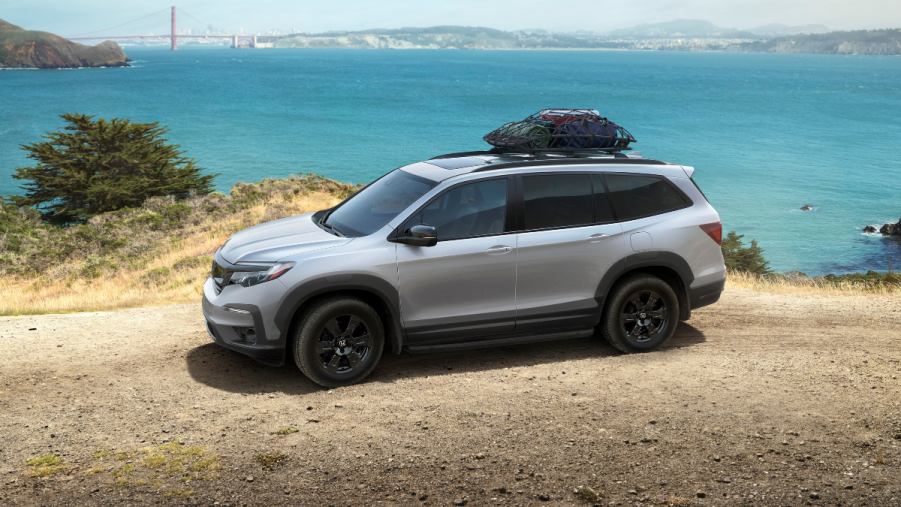
2022 Honda Pilot Takes on the 2022 Toyota 4Runner
Are you thinking about buying either the Honda Pilot or the Toyota 4Runner? To help you with your buying decision, we created this 2022 Honda Pilot vs. 2022 Toyota 4Runner comparison. See which SUV is the best choice for you.
2022 Honda Pilot vs. 2022 Toyota 4Runner

In our 2022 Honda Pilot vs. 2022 Toyota 4Runner comparison, we evaluated several different areas. This includes performance, efficiency, towing, off-road capabilities, safety, passenger and cargo space, interior features and technologies, warranty coverage, reliability, and price.
Pilot vs. 4Runner: Performance and efficiency

On the performance front, the 2022 Toyota 4Runner features a 4.0-liter V-6 engine, which generates 270 horsepower and 278 lb-ft of torque. In comparison, the 2022 Honda Pilot has a 3.5-liter V-6 engine, which produces 280 hp and 262 lb-ft of torque.
For efficiency, the Pilot has the advantage. It has an estimated fuel economy of up to 20 city/27 highway mpg, compared to a gas mileage of up to 16 city/19 highway mpg for the 4Runner.
Pilot vs. 4Runner: Towing
Do you need an SUV that can tow? The 4Runner and Pilot are evenly matched for towing, with a maximum towing capacity of 5,000 pounds.
Pilot vs. 4Runner: Off-road capabilities
If you’re aiming to head off-road, then the 4Runner is the better choice for you. For one, it has considerably higher ground clearance than the Pilot (up to 9.6 vs. 7.9 inches). Also, it has a more capable four-wheel drive system with an available transfer case, compared to the basic all-wheel drive system for the Highlander.
Furthermore, while the Pilot offers a new off-road-focused model with the new TrailSport trim, it doesn’t match the off-road prowess of the 4Runner TRD Pro, which includes off-road features like an off-road-tuned suspension, off-road drive modes, and all-terrain tires.
Pilot vs. 4Runner: Safety
The 4Runner and Pilot offer a similar roster of safety and driving assistance features. This includes a blind-spot monitoring system, lane departure warning, cross-traffic alert, brake assist, and electronic stability control. However, unlike the 4Runner, the Pilot offers a lane-keeping assist feature.
Pilot vs. 4Runner: Passenger and cargo space
The Honda Pilot is slightly bigger than the Toyota 4Runner, resulting in more passenger space. It has a total passenger volume of 152.9 cu-ft, compared to 128.0 cu-ft for the 4Runner three-row model and 93.7 cu-ft for the two-row model.
However, the 4Runner provides more storage space. It has a maximum cargo capacity of 89.7 cu-ft, compared to 83.9 cu-ft for the Pilot.
Pilot vs. 4Runner: Interior features and technologies
For interior features and technologies, the Pilot has the advantage. Unlike the 4Runner, the Pilot offers a rear climate control system, an interior cargo shade, rear-seat audio controls, and heated rear seats. Both SUVs offer a sunroof/moonroof.
Pilot vs. 4Runner: Warranty coverage and reliability
For warranty coverage, both the Pilot and 4Runner have the backing of a 3-year/36,000-mile basic warranty and a 5-year/60,000-mile powertrain warranty. However, unlike the Pilot, the 4Runner has a free maintenance plan, with two years and 25,000 miles of coverage.
Also, the 4Runner is more reliable than the Pilot. It earned a J.D. Power reliability rating of 81/100, compared to 79/100 for the Pilot.
Pilot vs. 4Runner: Price
Which SUV costs more: the 2022 Pilot or the 2022 Highlander? The starting prices of the Pilot range from $37,580 MSRP for the Sport trim up to $51,370 MSRP for the Black Edition trim. In comparison, the starting prices of the 2022 4Runner range from $37,305 MSRP for the SR5 trim up to $52,120 MSRP for the TRD Pro trim.
2022 Honda Pilot vs. 2022 Toyota 4Runner: Which SUV is better?
In our 2022 Honda Pilot vs. 2022 Toyota 4Runner comparison, each SUV has various advantages. For the 2022 Pilot, advantages include higher engine horsepower, efficiency, a lane-keeping assist feature, passenger space, and interior features and technologies. Conversely, advantages for the 2022 4Runner include higher engine torque, off-road capabilities, cargo space, a free maintenance plan, and reliability.


